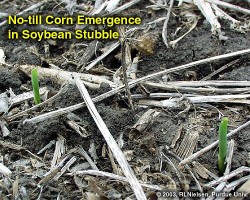

![]() niform no-till stand establishment of corn can be
difficult to achieve if conditions at planting are not ideal. Achieving
adequate seed-soil contact during the planting operation is often one of the
challenges involved with no-till planting into fields with high levels of
surface trash (aka residue).
niform no-till stand establishment of corn can be
difficult to achieve if conditions at planting are not ideal. Achieving
adequate seed-soil contact during the planting operation is often one of the
challenges involved with no-till planting into fields with high levels of
surface trash (aka residue).
 Adequate seed-soil contact helps ensure optimum moisture
absorption by the seed (aka inbibition) that is required for initiating the
germination process (Nielsen,
2002b). The consequences of uneven seed-soil contact are uneven germination
and emergence.
Adequate seed-soil contact helps ensure optimum moisture
absorption by the seed (aka inbibition) that is required for initiating the
germination process (Nielsen,
2002b). The consequences of uneven seed-soil contact are uneven germination
and emergence.
The consequences of uneven emergence are plants with delayed development that unable to successively compete with neighboring ones that emerged earlier. Yield losses to uneven emergence can easily be as great as 10 percent (Carter et al., 2002), so it is worth making the effort to prevent the occurrence of uneven emergence.
If the surface soil is excessively wet, the press wheels of the planter may not completely close the seed furrow. The intended seed-soil contact may instead consist of excessive seed-air contact in the open furrow. If the planter coulters do not slice cleanly through the surface trash, bits and pieces of the old crop or weed residue may instead be “hair-pinned” into the seed furrow. The intended seed-soil contact may be replaced by excessive seed-trash contact.
Whether it be seed-air or seed-trash contact, the affected kernels are greatly dependent on rainfall to help close the furrows, keep the furrow environment moist, or keep the pinned trash moist so that moisture is available for absorption by the kernel. Without adequate moisture levels, germination and emergence of the kernels will be delayed compared to areas of the row where seed-soil contact is adequate.
 Take the time during planting to check that
acceptable seed-soil contact is occurring in the furrow (Nielsen,
2002a). Increase the down pressure of the press wheels if necessary to
close the furrows or delay planting until the surface soil dries to a more
optimum level. Increase the down pressure of the coulters to better slice
through surface trash or delay planting until the surface trash is drier and
receptive to coulter cutting. If your planter is outfitted with trash cleaners
(aka row cleaners, residue managers, trash whippers), change their position to
more aggressively
clear
away the surface trash from the row area to minimize the risk of
“hair-pinning” the trash into the seed furrow.
Take the time during planting to check that
acceptable seed-soil contact is occurring in the furrow (Nielsen,
2002a). Increase the down pressure of the press wheels if necessary to
close the furrows or delay planting until the surface soil dries to a more
optimum level. Increase the down pressure of the coulters to better slice
through surface trash or delay planting until the surface trash is drier and
receptive to coulter cutting. If your planter is outfitted with trash cleaners
(aka row cleaners, residue managers, trash whippers), change their position to
more aggressively
clear
away the surface trash from the row area to minimize the risk of
“hair-pinning” the trash into the seed furrow.
Carter, P., E. Nafziger, and J. Lauer. 2002 (Rev.). Uneven Emergence in Corn. NCR Ext. Pub. No. 344. On-line at http://cf.uwex.edu/ces/pubs/pdf/NCR344.PDF [URL verified 4/29/03].
Nielsen, Bob. 2002a. Considerations for the Day of Planting. Purdue Univ. On-line at http://www.kingcorn.org/news/articles.02/Day_of_Seeding-0327.html [URL verified 4/29/03].
Nielsen, Bob. 2002b. Requirements for Uniform Germination and Emergence of Corn. Purdue Univ. On-line at http://www.kingcorn.org/news/articles.02/Germ&Emerg_Req-0520.html [URL verified 4/29/03].
Nielsen, Bob. 2002c. The Germination Process in Corn. Purdue Univ. On-line at http://www.kingcorn.org/news/articles.02/Germination_Process-0520.html [URL verified 4/29/03].
Steinhardt, G., K. Eck. R. Boehm, and D. Brown. 2002. A Dozen Do’s for Successful No-till Corn Following Soybeans. (AY-313). Purdue Univ. Coop. Ext. Service. On-line at http://www.agcom.purdue.edu/AgCom/Pubs/AY/AY-313.pdf [URL verified 4/29/03].